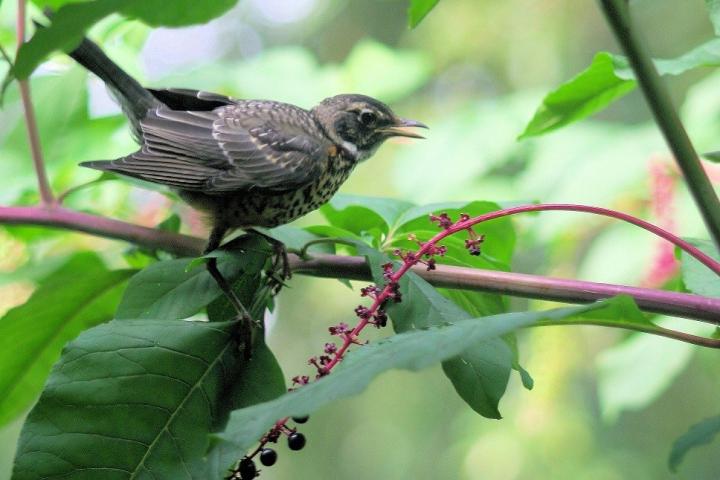Backyard birds enhance life in urban neighborhoods

Is a robin eating backyard pokeweed berries a welcome visitor or weed-spreading nuisance? Credit: C. Whelan
J. Amy Belaire of St. Edward's University, Lynne Westphal of the U.S. Forest Service, and Emily Minor and Christopher Whelan of the University of Illinois at Chicago visited urban neighborhoods in the Chicago area to answer these questions and learn more about how people see their backyard birds.
Their results, published in a new paper in The Condor: Ornithological Applications, provide a fascinating look at the relationship between people and nature in a city setting.
Belaire and her colleagues surveyed the breeding birds in 25 neighborhoods adjacent to forest preserves in Cook County, Illinois, recording a total of 36 species, and sent questionnaires to the families in each neighborhood.
While most people were excited to participate in a scientific study, according to Belaire, someone looking through binoculars in a residential neighborhood is bound to attract some attention; “The police were called several times to check up on us,” she says.
The researchers found that residents' feelings toward birds were generally very positive, although a few people found bird droppings, nests in gutters, and other nusiances to be annoying, especially in neighborhoods where specific problem birds such as House Sparrows and Common Grackles were more abundant.
Though the questionnaire asked respondents to estimate how many bird species were found around their homes, there was no relationship between residents' perceptions of bird diversity and the actual species numbers observed in the bird surveys. Instead, the more favorable someone's feelings about local birds, the more species they guessed were present.
“The interdisciplinary approach for this study stemmed from the knowledge that many of today's pressing environmental questions can't be answered by a single discipline alone,” says Belaire. “The social surveys helped shed light on the many things people value about birds in the neighborhood, especially the birds' aesthetic qualities and the role they play in local ecosystems.
Although residential neighborhoods in our study sites had surprisingly high bird diversity, we found that people didn't seem to be entirely aware of this biodiversity.” The researchers suggest that programs such as citizen science projects can increase people's awareness of their neighborhoods' avian diversity. Even though the results showed a range of individual awareness of birds, this study reinforces the idea that birds are an important point of connection between city dwellers and the natural world.
“Urban residents' perceptions of birds in the neighborhood: Biodiversity, cultural ecosystem services, and disservices” is available at http://www.
Media Contact
All latest news from the category: Life Sciences and Chemistry
Articles and reports from the Life Sciences and chemistry area deal with applied and basic research into modern biology, chemistry and human medicine.
Valuable information can be found on a range of life sciences fields including bacteriology, biochemistry, bionics, bioinformatics, biophysics, biotechnology, genetics, geobotany, human biology, marine biology, microbiology, molecular biology, cellular biology, zoology, bioinorganic chemistry, microchemistry and environmental chemistry.
Newest articles

Making diamonds at ambient pressure
Scientists develop novel liquid metal alloy system to synthesize diamond under moderate conditions. Did you know that 99% of synthetic diamonds are currently produced using high-pressure and high-temperature (HPHT) methods?[2]…

Eruption of mega-magnetic star lights up nearby galaxy
Thanks to ESA satellites, an international team including UNIGE researchers has detected a giant eruption coming from a magnetar, an extremely magnetic neutron star. While ESA’s satellite INTEGRAL was observing…

Solving the riddle of the sphingolipids in coronary artery disease
Weill Cornell Medicine investigators have uncovered a way to unleash in blood vessels the protective effects of a type of fat-related molecule known as a sphingolipid, suggesting a promising new…





















